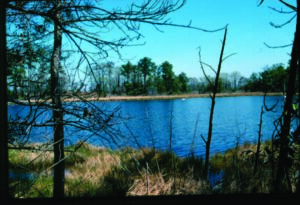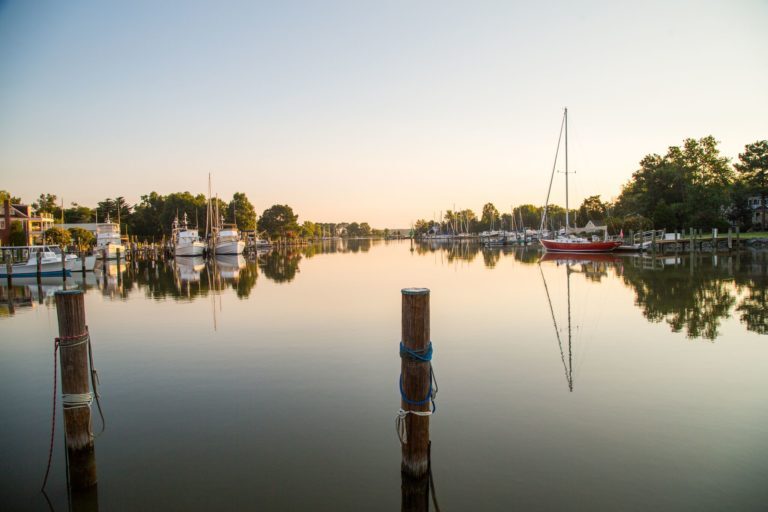Scenic Easements for the Poe-Burling Property
About the Property
The landowner came from an old Maryland family which had owned an early land-grant plantation on Maryland’s Eastern Shore for generations. The farm, known as Rich Neck, comprised 790 acres, more than five miles of Chesapeake Bay waterfront, and many historic buildings, including a very early, private Gothic revival chapel. The farm includes an entire peninsula that juts several miles into the Chesapeake Bay. An easement over a parcel of this size preserves a strong feeling of life in early Maryland.

The Land Trust
The Maryland Environmental Trust (MET) is a statewide local land trust governed by a citizen Board of Trustees.” A quasi-public agency, funded by the State of Maryland but with its own endowment, the Trust focuses on preserving natural resources, open space, and agricultural lands through the use of conservation easements. The Trust also helps local land trusts and provides grants for environmental education programs.
The Easement
A trusted family lawyer introduced the landowner to the idea of placing a conservation easement on the property. The landowner decided over several months to include restrictions on subdivision, new construction, timbering, and internal and external changes to the eighteenth-century manor house. At the insistence of the landowner, three organizations: The Maryland Environmental Trust, the Maryland Historical Trust, and the Nature Conservancy, jointly hold the easement. The landowner believed that multiple easement holders made it more likely that the easement would survive in perpetuity. This easement is a traditional conservation easement, rather than a scenic easement. All parties signed the easement on December 13, 1988.
What Scenic Resources Does the Easement Protect?
Talbot County, Maryland’s general plan calls for the protection of the beauty of its Chesapeake Bay waterfront. The easement specifically references this goal. With its protection of several miles of waterfront, the easement serves that goal as well. Moreover, an appendix to the easement lists all the structures on the property and refers to their dates of construction and protection status under the easement. Several, including the Rich Neck Farm Main House, the chapel, a guest house, and several farm structures, have exteriors protected under the easement.

Key Scenic Conservation Strengths of the Easement
The easement contains several key provisions related to the protection of watersheds, farming practices, and design protection for the many significant structures. The easement requires the establishment and maintenance of vegetative buffers between agricultural operations and streams. This provision not only protects the water quality and supply but offers scenic enhancements to the property.
Also, like most easements, this one prohibits billboards. Furthermore, it limits the size of all signs to 4 feet by 4 feet. In addition, the easement prohibits commercial activities other than those directly related to the continued agricultural use of the property. Perhaps the easement’s greatest strength is its protection of historically significant structures. Modifications to the exteriors of those structures must be consistent with their historic character. The landowner must maintain the main house consistent with its character. Moreover, the easement shows a strong preference, for new construction that is compatible with the historic character of the site. In doing so, and in requiring the landowner to maintain and preserve existing structures, the landowner and the easement holders serve both the distinctive character of the Rich Neck area and the purpose of the easement.
Potential Weaknesses of the Easement
The provisions in this particular easement appear to be well-suited to the site. However, one stands out as a weakness that should concern either the landowner or the easement holders. That one provision is a sentence in Article V., Enforcement and Remedies, which requires the easement holders to limit inspection visits to once per year. If the key scenic resources are visible from off-site, then a drive-by and/or sail-by inspection could suffice. If, however, key protected resources are not visible from off-site, a future landowner could do significant harm in a year between inspections.
Key Enforcement Clauses and Other Noteworthy Procedural Language
Most of the enforcement clauses are fairly standard. However, one particular bit of language stands out. As noted in the introduction to the easement above, three entities, The Nature Conservancy, the Maryland Environmental Trust, and the Maryland Historical Trust, are co-holders of the easement. In paragraph D of Article V, Enforcement and Remedies, the Maryland Historical Trust is responsible for monitoring and enforcing the historic and archaeological provisions of the easement, with the Maryland Environmental Trust responsible for compliance with other terms. This division of labor based on expertise is sensible and could be a model for other easement partnerships.
Conclusion and Assessment
The property is one of great importance. The easement, though older than some, is quite good, balancing the desires of the landowners to keep farming, the need to protect the historic structures and scenic waterfront of the property, and the roles of the three easement holders.
